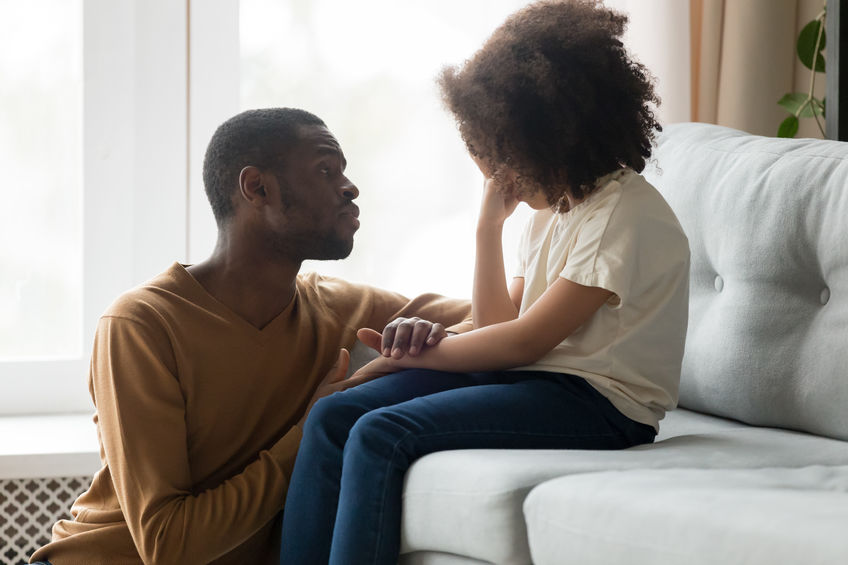
Anything that's human is mentionable, and anything that is mentionable can be more manageable. When we can talk about our feelings, they become less overwhelming, less upsetting, and less scary. The people we trust with that important talk can help us know that we are not alone.
~Mister Rogers
Unfortunately, violence is a part of the “norm” in so many children’s lives. But there is nothing normal about living with the constant fear of our children being harmed. As we grapple with what can be done to change the “norm” and ensure their safety and their ability to just be kids, we need to focus right now on how to help them understand all the confusing and frightening news they are absorbing.
Before we can help our children understand and manage how they are feeling we need to first become aware of and deal with our own anxiety, worries, and fears.
Children are always looking to the important adults in their world for reassurance and guidance and their safety. Our actions, reactions, and responses are informing them. By taking stock of our own emotions, we can then be available to our children in a calm and focused way to help them deal with their genuine fears and anxieties.
Like us, our children are confused and scared and their feelings may be expressed through their actions especially as they may not have the words to express how they feel. You may observe changes in their behavior. They may be anxious when you leave or may want to only be with you. They may have difficulty sleeping or show changes in eating patterns. They may act up or act out.
Although we may feel powerless in how to be there for our children in the face of such tragedy, we do have the power to help them begin to process and deal with their emotions, and most importantly to feel that their safety net is secure.
As parents and educators, the best we can do to help our kids in tragic moments such as these is to talk honestly and openly. To help them to identify, express, and understand all they are trying to make sense of in the world and in themselves. To be there to listen, to provide accurate developmentally appropriate information, to make good choices for the types of media they are consuming and how much access they have to media. To spend comforting time together, and to be there offering lots of warm, reassuring, and responsive hugs, and more hugs.
Related: The Ultimate Guide for Talking to Kids About Tough Topics
Be sure you are allowing yourself to be aware of your own emotions by becoming aware of and dealing with your own anxiety, worries, and fears. This way, you can approach your child in a calm and focused manner and be better available to help them deal with their concerns.
Encouraging children to talk about what they have seen and heard, and how they are feeling. Be open, inviting, and reassuring in your language, and let your child’s many questions guide the direction of the conversations.
It is ok to be confused and wonder why things happen. By letting children see and understand that you have feelings and emotions helps validate how they are feeling, and to know that feelings are okay.
Be mindful and informed about the information you are sharing, sorting out misinformation and hearsay from accurate facts. Identifying where the information is coming from, and helping your child to do the same, will help you answer questions responsibly and empathically.
Provide developmentally appropriate answers (“sometimes we don’t like what happens in the world”). Don’t overload them, or yourself, with info. Remember less is more, and don’t become overly detailed and descriptive with details.
Find out where kids are, and what they are ready to take in. It is ok not to have answers. But keep the conversational door open, addressing things as they arise and checking in with your kids as events evolve. Give kids facts and context without judgment.
Validate how kids are feeling and help them understand that how they feel is understandable and ok. Everyone has big emotions, especially now.
Keep to routines whenever possible. Help children to know that there is good in the world; Mister Rogers always said, “When something scary is happening, look for the helpers. You will always find people who are helping.” Showing children all the people working to help and reading about organizations and heroes provides reassurance.
Help kids to find ways they can help. Help them feel a part of a community of helpers by engaging in planned activities at your child’s school or in the community. There is agency and empowerment in coming up with and participating in actionable ways. Providing children with opportunities to feel that they can have a “voice” and reach out to a school just like theirs that is going through a horrible time, this also allows them to develop kindness and empathy. Ask children to think about how they might be helpful — let creativity take hold here, from artwork and letter writing to fundraising on the front lawn.
Limit news exposure, but don’t avoid what is happening. Point to the heroes.
These Posts on Parenting
Housman Institute, LLC
831 Beacon Street, Suite 407
Newton, MA 02459
info@housmaninstitute.org
(508)379-3012
Explore
Our Products
Legal
Connect
Contact
Join our Mailing List!
Subscribe to receive our newsletter, latest blogs, and SEL resources.
We respect and value your privacy.
Comments (1)